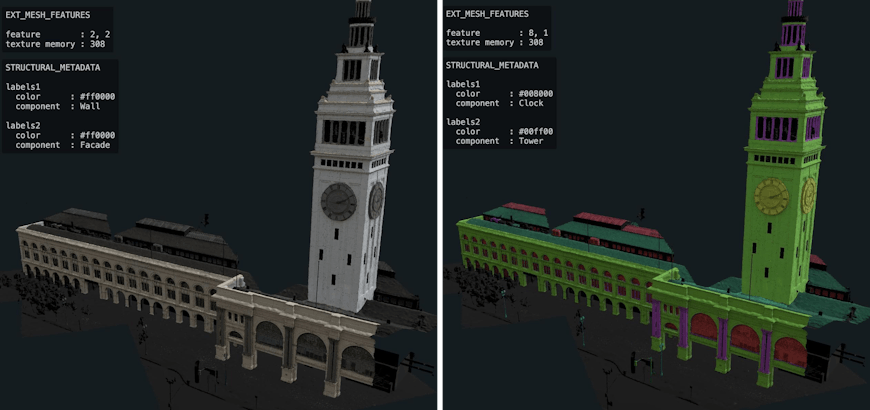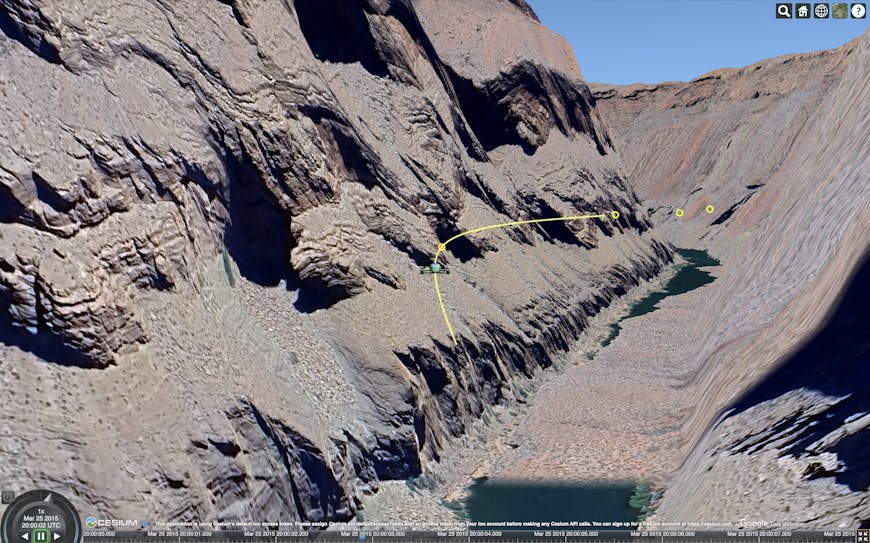Cesium Releases in October 2024
In September, we introduced the AECO Tech Preview Program, highlighted our summer Refactor, shared that we’ve joined Bentley Systems, featured enhancements to the Three.js 3D Tiles renderer, and announced grant support for the Cesium plugin for Godot.

Visualization of structural metadata and mesh features from 3D Tiles 1.1 is now possible in Three.js with the San Francisco Ferry Building.
We made improvements across Cesium this month. To get notifications about our monthly releases, you can subscribe to the Cesium release roundup thread on our community forum.
CesiumJS 1.122 Release
CesiumJS 1.122 is now available. Highlights of the release include:
- Added
CallbackPositionPropertyto allow lazy entity position evaluation. #12170 by new contributor jfayot - Added
enableVerticalExaggerationoption to models. Set this value tofalseto prevent model exaggeration whenScene.verticalExaggerationis set to a value other than1.0. #12141 by new contributor timeichfeld-msa - Fix
Textureerrors when using aHTMLVideoElement. #12219 - Fixed noise in ambient occlusion post process. #12201
For more details, see the changelog.

The new CallbackPositionProperty allows Entities to lazily evaluate a position. Here, it’s used to track a drone flying through the Grand Canyon, as visualized using Google Photorealistic 3D Tiles.
Cesium for Unreal 2.9.0 Release
Cesium for Unreal v2.9.0 is now available. Highlights of the release include:
- Added
SampleHeightMostDetailedfunction toCesium3DTileset, which asynchronously queries the height of a tileset at a list of positions. It is callable from both C++ and Blueprints. - Drastically reduced tile mesh memory usage in UE 5.3 and 5.4 by working around a bug that causes those engine versions to add more texture coordinate sets than necessary.
- Fixed a bug where the
scale,noData, anddefaultvalues of a property inEXT_strutural_metadatawere not correctly passed to the tileset's material.
Check the Cesium for Unreal release and the Cesium for Unreal Samples release for the full list of updates.

Trees and rocks floating above Cesium World Terrain, with lines drawn to where they would fall on the hills below them.

The same trees and rocks placed on the terrain using SampleTerrainMostDetailed. Assets provided by Quixel Megascans.
Cesium for Unity 1.13.0 Release
Cesium for Unity v1.13.0 is now available. Highlights of this release include:
- Added a new
CesiumCameraManagercomponent. It allows configuration of the cameras to use forCesium3DTilesetculling and level-of-detail. - Added
SampleHeightMostDetailedmethod toCesium3DTileset. It asynchronously queries the height of a tileset at a list of positions. - Fixed a bug that could cause a
NullReferenceExceptionwhen aCesium3DTilesetwas not nested into a game object with aCesiumGeoreference.
Check the Cesium for Unity changelog for the full list of updates, and follow our Cesium for Unity tutorials to get started.

Use the new Cesium Camera Manager component to control which cameras are used for 3D Tiles culling and level-of-detail.
Cesium for Omniverse 0.23.0 Release
Cesium for Omniverse v0.23.0 is now available. Highlights of this release include:
- Fixed bug where tilesets and raster overlays were not being passed the correct custom ellipsoid.
- Fixed rendering base color textures that contain an alpha channel.
Peruse the changelog for the full list of updates, and get started with our Cesium for Omniverse tutorials.
Cesium ion Updates
Cesium ion SaaS
- The Cesium ion Reality Tiler was updated with performance improvements.
Cesium ion Self-Hosted
Cesium ion Self-Hosted 1.4 will be released this week. Highlights will include:
- Reality Tiler performance improvements.
- CRS option availability for reality tiler and the point cloud tiler command line interface.
- Linking to individual Cesium Stories slides.
- Duplicating Cesium Stories and Cesium Stories slides.
Check the changelogs for the full list of updates for Cesium ion SaaS and Cesium ion Self-Hosted.
Powered by Cesium
Pennoni is moving engineering from graph paper to streaming 3D models with Cesium for Unreal and Google Photorealistic 3D Tiles. Pennoni’s engineers, with collaborating architects, create 3D models for proposed structures using CAD data, point clouds, or photogrammetry. Pennoni loads these directly into Unreal Engine, ensuring accurate placement and lighting with Cesium for Unreal, and streams Google Photorealistic 3D Tiles via Cesium ion for real-world urban context, so the future view is clear.

Proposed “dolphin” cylinder protection at Delaware River and Bay Authority (DRBA)’s Delaware Memorial Bridge. Courtesy Pennoni.